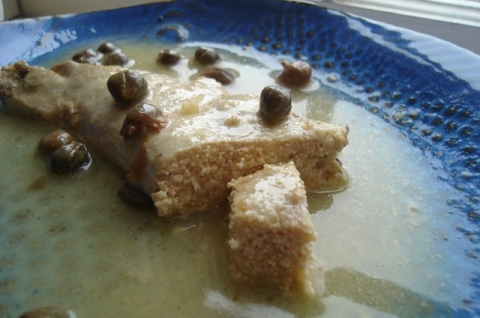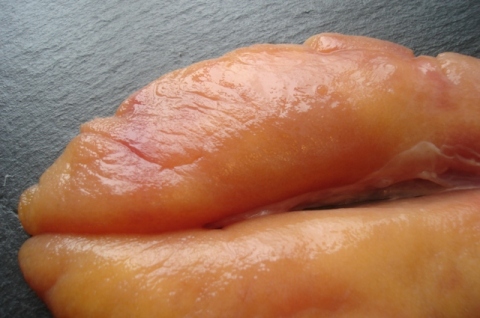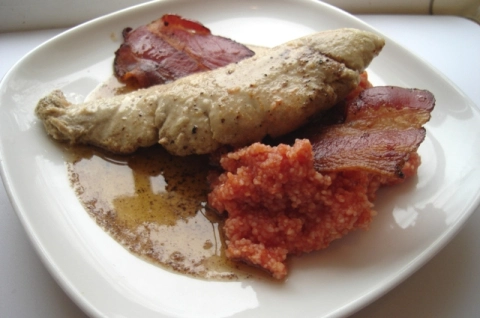Shad Roe, Two Ways
March 3, 2008
Earlier this spring, I decided this year was the year. The year I was at least going to try it. I’m normally a pretty adventurous eater, generally willing to try new things. But I had put off trying shad roe for for a couple of years now and it had become one of my darkest waitressing secrets. “Oh, the shad roe?” I’d say brightly. “It’s excellent here.” Or so I’d heard. Then I would wait for the inevitable question, and cringing, try to explain that shad roe were two paired lobes of egg sac of the shad without using the words “egg sac,” which usually make guests wrinkle their noses and shake their heads. Shad roe eaters are a club of their own and, in my waitressing experience at least, if you don’t already know what it is, chances are you don’t want to.
But, other than the egg sac concept, I loved the idea of shad roe. It’s intensely seasonal, a harbringer of spring, and local to boot. Shad run up the East Coast every spring to spawn in fresh water and fishermen in the Chesapeake Bay and the Hudson River celebrate their coming with shad bakes and festivals. The fish itself is flavorful, but quite bony, making it a challenging eat. The roe itself has been described as rich and “tasting of the sea,” a bit briny.
Still slightly apprehensive, I did not want to try the roe at work, scarfing it down as I tried to finish my sidework at the end of the night. I decided this should be an occasion of sorts and so I talked Chef into letting me bring my shad home to cook myself. I wrapped them up and carefully brought them home. At which point R., my (kitchen professional) boyfriend, mentioned that they could be difficult to saute properly, being liable to burst at high temperatures, and casting a bit of doubt on the whole enterprise. So I began my research, finding that the generally accepted solution to this bursting problem is a light poaching followed by pan searing for color. I had settled on this method when I came across a recipe from Jasper White’s Cooking from New England via The Spiral Staircase. Mr. White seemed to have put quite a bit of thought into the preparation of shad roe and anyone who wants to poach food in butter has my heart from the get go. All this, paired with his cautionary words on popping fat, and I was sold.
“Shad roe does not take well to any type of intense heat. It requires gentle cooking. If you wish to saute shad roe, you must gently poach it first. It is too delicate to saute from the raw state. You can . . . then season and dust the roe with flour before slowly browning it in butter or bacon fat. Be careful of popping, which can throw hot fat far enough to burn the cook. Over the years, I have tried just about every known method for cooking shad roe. Still not completely happy, I invented my own method, which pays heed to the most important elements in cooking shad roe: slow cooking and basting. The trick is to find a saute pan that is just barely big enough to hold the roe. For one pair weighing about six ounces a six-inch pan with one-inch sides is perfect; for two pairs of that size, a nine-inch pan is about right. The roe is roasted slowly in this pan with enough sweet butter to almost cover the lobes. This eliminates basting, and since the dish is started from the cold state and uses a very gentle cooking, it also eliminates poaching. When the roe is perfectly cooked, it is transferred to a warm plate to rest for just a moment, while you prepare a brown butter from the butter in the pan… Serve one piece of lobe as an appetizer or two as a main course. I think the richness of this dish, however, makes it more appropriate as a starter.”
So the cooking method decided, I was torn between a lemon caper butter that the restaurant relies on or a more traditional approach, one that would let me use some of my home-cured bacon. I dithered for a while before deciding that it was a sign that shad roe come paired with two lobes and I was meant to try both. The lemon caper butter approach would use up the butter I had needed to poach the roe and would pair with some grilled bread. I put R. and his professional background in charge of this while I worked out what to do with the bacon. Bacon, grits, and roe seemed to be a theme in my readings. Going along those lines, I would fry up some bacon, build a pan sauce with brandy and serve this roe variation with some of my smoked tomato grits, which are good enough to deserve a post of their own.
Honestly, after all this build up, the roe seemed almost anticlimactic. It was good, with a mild flavor and a texture not unlike the grits that I paired them with. The acidic counterpoint of the lemon and capers paired beautifully with the roe and anything with bacon is yummy in my book. I would eat roe again, but probably not seek it out, and that’s okay, because now I know what all the fuss is about. You can send me my shad roe club membership card, because now I’ve tried it.
Shad Roe, Slowly Roasted in Butter
adapted from Jasper White’s Cooking from New England
preheat oven to 350 degrees.
-
1 pair shad roe lobes, about 6 oz
-
salt and freshly ground black pepper
wash shad roe and gently pat dry. season with salt and pepper.
-
6-8 tablespoons unsalted butter
place a 6-inch saute pan on medium low heat and melt 6 tablespoons of the butter. slip the shad roe into the pan, making sure that the melted butter is covering the lobes. if not, add a bit more. place the pan into the preheated oven. check the thickest part of the roe after 12 minutes for firmness. if still soft, cook a bit longer. remove to a warm plate.
Lemon Caper Pan Sauce and Grilled Bread
pour off part of the melted butter from the pan and reserve to brush grilled bread, leaving behind 3-4 tablespoons. place over medium heat to brown the butter. toss in
-
1 tablespoon salt-cured capers, soaked and dried
-
juice of 1/2 a lemon
-
salt and pepper to taste
swirl to incorporate.
-
2 slices of baguette, cut on the bias, toasted or grilled, brushed with any melted butter left
Brandied Bacon Pan Sauce
-
2 slices of thick-cut bacon
fry up bacon until crisp. remove from pan and remove pan from heat. add
-
1/3 cup brandy or bourbon
swirl and light with a long kitchen match. season to taste with salt and fresh ground pepper. if I tried this again, I would probably add a pinch of flour to the bacon grease to make a thin roux or some heavy cream after the brandy to make a more finished sauce.




